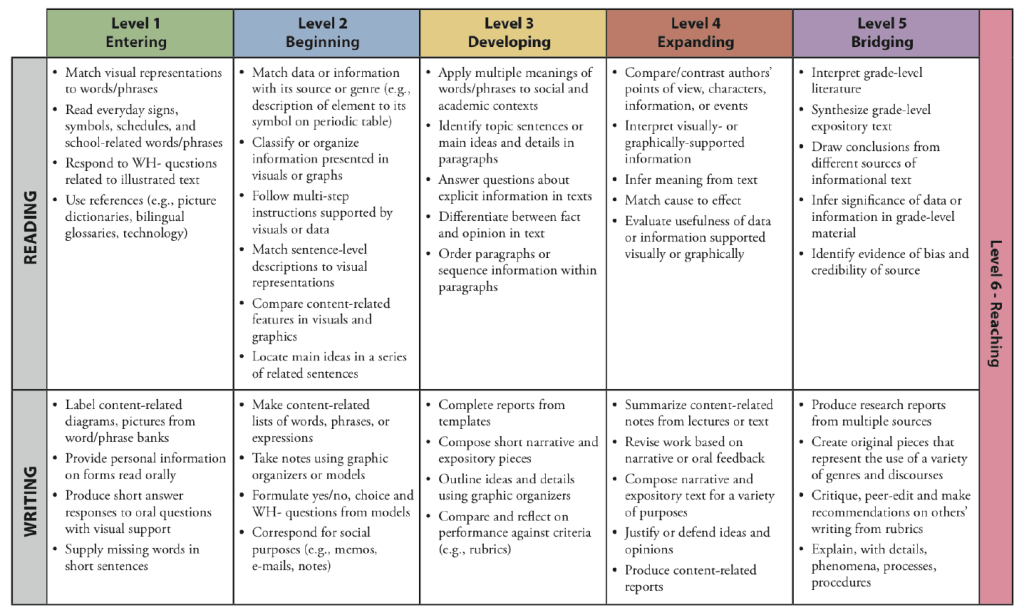
How “WIDA Can-Do Charts” Help Me Plan and DifferentiateInstruction for English Language Learners?

What is WIDA Can-Do Chart?
The WIDA Can-Do Descriptors document is a number-one tool I make sure to fill out at the beginning of the school year. For those who need to refresh your memory, WIDA Can-Do Chart provides examples of academic language use for four specific communicative purposes: Reading, Writing, Listening, and Speaking.
The information you need to fill out WIDA Can-Do Chart is ACCESS scores of your ELLs available through your ACCESS coordinator or Ellevation.com platform for which you would have an account from your school.
In my school, I have an account on Ellevation.com where I download the WIDA ELP Standards Report. I look through each student’s report and record the ACCESS scores in the areas of Writing, Reading, Listening, Speaking.
Note: I do not differentiate between 1.2 and 1.6 because on the WIDA Can-Do chart the students with 1.2 and 1.6 scores in Reading, for example, will go into the same category.
How can WIDA Can-Do Chart be useful?
Without reinventing the wheel, I turn back to the info provided by WIDA. This is what I see: “Key Uses Edition can help….
- Differentiate curriculum, instruction, and assessments designed in English based on language learners’ levels of English language proficiency,
- Collaborate and engage in instructional conversations about the academic success of language learners in English environments,
- Advocate for equitable access to content for language learners based on their level of language proficiency”.
Honestly, it sounds too academic and/or theoretical. This was one of the reasons I have been uncomfortable to use WIDA for quite some time, forget about my first year: it was Greek to me.
But then, as I would ask myself over and over again, “How do I know where my students are in terms of their language development?”
Most importantly, I needed to figure out what I could do if I knew the exact levels of English language proficiency of my students. Therefore, I decided to give WIDA can-do charts one more chance, and I started, unwillingly at first, to study and interpret what I knew about my students and how this information could be helpful.
How do I work with WIDA Can-Do Charts?
The first thing I did was to write down the names of my students in each of the four categories based on their ACCESS scores.
Then, groups form. These groups pretty much matched what I’ve observed about my students, so it gave me an a-ha understanding of what I might be able to discover.
Since I already figured out the purpose of grouping ELLs based on their scores, what I did next was I started decoding the information given in the Key Uses of language: Recount, Explain, Argue.
What does it mean a student can recount by “Naming and briefly describing past community or school events using visual support (e.g., posters, photographs)”?
How can I use the knowledge of it in my everyday work?
And then it clicked!…
Depending on the proficiency level captured in ACCESS scoring and the Key Use of language a student is required to demonstrate, I can determine whether a particular assignment will be doable for a student, and if not, I knew how to modify it!
Example #1:
• My L1 student in Speaking Alexander is able to Argue By “Responding yes or no to short statements or questions related to a claim.” This makes it clear that whenever I use an anticipation guide strategy at the beginning of my unit, it makes sense to offer Alexander a list of statements about a claim that he could identify as Ture or False. This will be the way for him to argue certain aspects of the claim in a discussion.
• My L4 student in Speaking Joceily can Argue By “Connecting ideas with supporting details or evidence .” This means whenever I use an anticipation guide strategy at the beginning of my unit, it makes sense to offer her a claim and ask her to think about and formulate 3-4 ideas about the claim and support them with evidence.
Example #2:
In writing, Alexander is L1 again while
It means that if I want Alexandre to express his ideas in writing about a particular character of the book, I can offer him to select already brainstormed ideas about a character and fill out a few sentence frames using the chosen ideas.
How do WIDA Can-Do Charts help differentiate?
How can I remember which student performs at which level? Well, the truth is it WAS overwhelming at the beginning, but the more often I referred to WIDA Key Uses and took them into consideration while planning activities for my ELLs, the more automated the process became and patterns of techniques and differentiated activities would repeat themselves across the content areas where I was working with my students.
Another essential idea about WIDA Can-Do descriptors and Key uses of the language is that Key Uses of a language for each of your students can be the data you can use to justify the choice of particular activities as well as your expectations for each student if your administration raises a question about it, be it observation or lesson planning.
Finally, the knowledge and use of WIDA Can-Do descriptor will make whatever you do manageable for your students, thus students will feel more successful, and your lessons will be more engaging.
I wish you luck in your teaching!
Don’t forget to subscribe Un-SeriousTeacher and connect on Instagram @unseriousteacher.




